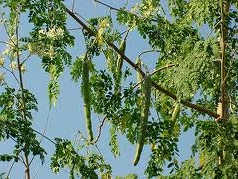
English Curriculum Training
Six Step Pattern of Ministry
Sowing the Jesus Seed
Yoruba Lessons
Super Fruit Series
Moringa Project
Youth Discipleship Training
|
|
home>> food
for life africa >>moringa
miracle tree>> ewe igbale
Ewe Igbale
For centuries, the natives of northern India
have known of the many benefits of Moringa Oleifera. Its
uses are as unique as the names it is known by, such as
Horseradish tree and Drumstick tree (referring to the large
drumstick shaped pods) and in East Africa it is called "Mother's
best friend”.
 |
In Nigeria the Igbos calls it “Idagbole
monoye” or 'Okwe Oyibo’ and the Hausas calls
it 'Zogelle,' ‘Gawara’ or ‘Habiwal’
In some parts of Nigeria it is called Ewe
Igbale, Adagba Maloye, or Igi Agunmaniye in Yoruba.
|
In Africa Moringa trees have
been used to combat malnutrition, especially among infants
and nursing mothers.
Three non-governmental organizations in particular
- Trees for Life, Church World Service and Educational Concerns
for Hunger Organization - advocate Moringa as “natural
nutrition for the tropics.” |
|
|
|
 | |
 |
Leaves can be eaten fresh,
cooked, or stored as dried powder for many months without
refrigeration, and without loss of nutritional value. Moringa
is especially promising as a food source in the tropics
because the tree is in full leaf at the end of the dry season
when other foods are typically scarce.
|
| Analyses of the leaf composition
have revealed them to have significant quantities of vitamins
A, B and C, calcium, iron and protein. According to Optima of
Africa, Ltd., a group that has been working with the tree in
Tanzania, "25 grams daily of Moringa Leaf Powder will give
a child" the following recommended daily allowances: |
|
 |
-
Protein 42%,
-
Calcium 125%,
-
Magnesium 61%,
-
Potassium 41%,
-
Iron 71%,
-
Vitamin A 272%,
-
Vitamin C 22%.
|
These numbers are particularly astounding;
considering this nutrition is available when other food sources
may be scarce.
Scientific research confirms
that these humble leaves are a powerhouse of nutritional value.
Gram for gram, Moringa leaves contain:
- SEVEN times the vitamin C in oranges,
- FOUR times the Calcium in milk,
- FOUR times the vitamin A in carrots,
- TWO times the protein in milk
- THREE times the Potassium in bananas.
|
|
The Moringa tree has great use medicinally both as preventative
and treatment. Much of the evidence is anecdotal as there has been
little actual scientific research done to support these claims.
India's ancient tradition of ayurveda says the leaves of the Moringa
tree prevent 300 diseases. One area in which there has been significant
scientific research is the reported antibiotic activity of this
tree.
The immature pods are greatly
valued and widely used. The pods are extremely nutritious,
containing all the essential amino acids along with many vitamins
and other nutrients. The immature pod can be eaten raw or
prepared like green peas or green beans, while the mature
pods are usually fried and possess a peanut-like flavor.
The pods also yield 38 - 40% of non-drying,
edible oil known as Ben Oil. This oil is clear, sweet and
odorless, and never becomes rancid. Overall, its nutritional
value most closely resembles olive oil. |
|

|
The leaves are
eaten as greens, in salads, in vegetable curries, as pickles
and for seasoning. They can be dried and pounded and sprinkled
over food or added to milk. Leaves and young branches are
relished by livestock. In developing tropical countries.
Moringa trees have been used
to combat malnutrition, especially among infants and nursing
mothers.
|
CLICK
on the links to view an English You Tube video on Moringa 'The
Miracle Tree'
SOWING SEEDS OF SUCCESS - MORINGA CURRICULUM
HEAL A HURTING HEART - CORONA CRISIS
|
|
|













































































